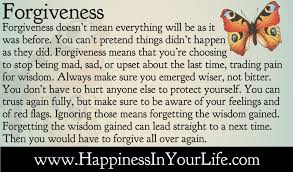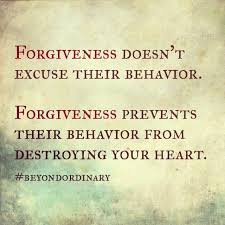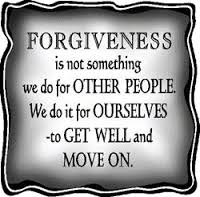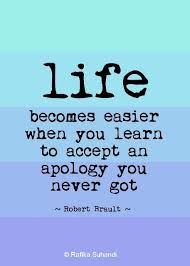“Recognise the stages of grief (denial, anger, bargaining, depression and acceptance) and honour wherever you fall in the process”
Archbishop Desmond Tutu and his daughter Reverend Mpho Tutu have written a book called: The Book of Forgiving: The Fourfold Path for Healing Ourselves and our World. I read about this book in the You Magazine (http://www.you.co.za) dated 15 May 2014 and thought I should share some of this with you.
In this book the authors speak of the fourfold path to forgiveness, i.e.
1) Telling your story to the person you have to forgive
2) Naming the hurt
3) Granting forgiveness
4) The renewal or release of a relationship
Forgiveness is not something we give to the other person. In reality, it is something we give ourselves – we get to cut the chains holding us to the person who hurt us. Forgiveness is not easy – to be angry, devastated and grief-stricken are all valid and appropriate responses – they are all part of the journey of forgiveness.
How do we start the journey of granting forgiveness or being forgiven?
The authors talk about The Revenge Cycle:
“Whenever we’re injured we face the choice of whether to retaliate or reconnect”, the authors write.”
The revenge cycle looks like this:
• Hurt, harm or loss
• Pain
• Choosing to harm
• Rejecting shared humanity
• Revenge, retaliation, payback
• Violence, cruelty
• Hurt, harm or loss
The forgiveness cycle follows a fourfold path.
In choosing to heal . . .
• We tell the story
• Name the hurt
• Grant forgiveness (recognising shared humanity)
• Renewing or releasing the relationship
The authors then give very useful and practical exercises to be completed. (I’ve heard of similar exercises like writing a letter to the person who hurt you and then to throw the letter into a fire or to burn the letter to release the feelings of hurt and to move on with your life). The exercises provided in the book are as follows:
THE STONE RITUAL:
Carrying the stone:
• You need a stone the size of the palm of your hand
• For one full morning (about six hours) hold the stone in your non-dominant hand i.e. if you are right-handed, you will need to carry the stone in your left hand and vice versa. Do not put the stone down for any reason during this six hour period.
• At the end of six hours, proceed to the journal exercise (the journal will only be read by you).
JOURNAL EXERCISE:
• What did you notice about carrying the stone?
• When did you notice it most?
• Did it prevent you from completing any other activities?
• Was the stone ever useful?
• In what ways was carrying the stone like carrying an un-forgiven hurt?
• Make a list of people you need to forgive in your life
• Make a list of all those you’d like to have forgiven you
THE CLOAK OF SAFETY (Mindfulness Exercise):
Forgiveness can sometimes feel like it’s too much work, when all you want to do is to be still and feel safe. Create a cloak of safety that will always be within reach.
• Start by sitting comfortably. You may prefer to close your eyes lightly.
• Pay attention to your breathing. Don’t direct it – follow it. (Think about how your chest moves up when you breathe in and down when you breathe out).
• When you have settled into the rhythm of your breathing, allow yourself to feel the cloak of safety surrounding you like fabric.
• What is the texture of this cloak? Does it have a colour? Does it have a fragrance?
• Settle into this cloak. Does it feel warm or cool?
• Describe this cloak in your imagination as fully as you are able to. Pull the cloak around you and settle into feeling safe.
• When you need this cloak, know it is there and you can just reach for it.
THE BOX OF SORROWS:
You may want to surround yourself with the cloak of safety you created.
• Create a safe space. Think about a place of safety. It could be real or imaginary. See this place fully and inhabit it. Relax into this place.
• Someone is calling for you. The one who is calling for you speaks in a voice filled with warmth, love and delight. When you’re ready, welcome this person into your safe space. Who is your companion? Is it a loved one, a friend or a spiritual figure?
• Between you and your companion sits an open box. Tell your companion the story of the hurt you carry. Tell the truth about how you have been wounded, disdained, disrespected, shamed or disregarded in as much detail as you can remember. As you speak, see the hurt and the words pouring out of you like a stream. Watch the stream being poured into the box. When you’ve said all there is to say, close the box of sorrows.
• Take the box into your lap. When you are ready, hand the box to your trusted companion. Know that the box is in safe hands. You don’t need to carry those sorrows any longer.
• When you are ready, you may leave your place of safety. Know that your trusted companion will take your box of sorrows from the place but will return it should you have a need for it.
HOW TO ACKNOWLEDGE THE HARM DONE:
If a friend comes to you asking you to help them with their process of forgiving you should do the following:
• Listen
• Do not try to fix the pain
• Do not minimise the loss
• Do not offer any advice
• Do not respond with your own loss or grief (don’t tell your own story)
• Keep confidentiality
• Offer your love and caring
• Empathise and offer comfort
JOURNAL EXERCISE:
Forgiveness is a process of letting go:
• Think of the things you must give up or let go in order to forgive. The list might include things such as the right to revenge or the expectation of an apology. It might even include having to give up an expectation that the person who hurt you will understand the pain they have caused.
• As you make your list, pause with each item and offer thanks for the ability to let go of what you don’t need in order to forgive.
NAMING THE HURT:
• Identify the feelings within the facts. Remember, no feelings are wrong, bad or invalid.
• Recognise the stages of grief (denial, anger, bargaining, depression and acceptance) and wherever you fall in the process.
• Find someone who will acknowledge you and listen to your feelings without trying to fix them.
• Accept your own vulnerability.
• Move forward when you are ready.
GRANTING FORGIVENESS:
• Forgiveness is a choice
• We grow through forgiving
• Forgiving is how we move from victim to hero in our story
• We know we are healing when we are able to tell a new story
RENEWING OR RELEASING THE RELATIONSHIP:
This is a stone ritual in which you decide whether you should release the stone and all it symbolises or turn it into something else.
• Decide whether you will turn your stone into a new thing of beauty or release it back into nature.
• If you have chosen to renew the stone, decide how you will paint it or decorate it. You may also choose to turn it into something useful in your home or garden.
• If you have chosen to release your stone, you may take it back to the place where you found it and put it down or you may take it to a new place that is meaningful to you.
• Nothing is wasted. Everything, even a stone, has its purpose.
JOURNAL EXERCISE:
• Was it possible to make something beautiful from what you had?
• How difficult was it to do so?
• What did you learn about the renewing and releasing [of a relationship] as you completed this exercise?
WHAT TO DO IF YOU NEED TO BE FORGIVEN:
• Get the support you need.
• Admit the wrong (although the path to making it right may or may not include telling your story to the person you have injured. Revealing an unknown betrayal may cause a deeper injury to the victim than that person’s ignorance or your deed. If this is the case, tell your story to a trusted counsellor).
• Witness the anguish and apologise.
• Ask for forgiveness.
• Make amends or whatever restitution or reparation is called for or needed.
• Honour your victim’s choice to renew or release the relationship.
STONE RITUAL: SETTING DOWN THE STONE:
• You will need a heavy stone. You want to feel its weight as burdensome.
• Walk with this stone some distance to a private place.
• Admit to the stone what you’ve done.
• Then tell the stone the anguish you have caused.
• Apologise to the stone and ask for forgiveness. You may imagine the person you have harmed in your mind’s eye or ask God for forgiveness.
• Decide what you can do to make amends to the person you harmed or how you can help others.
• Then set the stone down in nature.
Wow, this sure is powerful stuff. There is so much food for thought here. The exercises are simple yet practical. Just reading all of this makes me want to go out to buy the book, don’t you?
The Book of Forgiving: The Fourfold Path for Healing Ourselves and the World by Desmond Tutu and Mpho Tutu (Harper Collins) is available through http://www.kalahari.com
PEACE
It does not mean to be in a place where there is no noise, trouble or hard work, it means to be in the midst of those things and still be calm in your heart.
– Unknown








